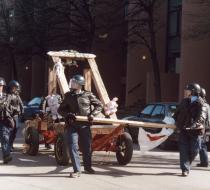The Teddy Bear Catapult 1 Favorite
It was a classic summit protest at the height of the anti-globalization movement. Thirty-four heads of state from across the Americas were gathering in Québec City to negotiate the Free Trade Area of the Americas (FTAA), a sweeping trade deal with deeply anti-democratic provisions. Protests had been called, tens of thousands were expected to fill the streets, and a giant fence defended by thousands of riot police was to be erected around the Old City to keep protesters far from the convention center.
Activists with pots and colanders on their heads pulled the full-size catapult up to the fence and began gently lobbing teddy bears into lines of riot cops.
As the summit drew closer and heated debates raged in activist circles about how to oppose the FTAA most effectively, a group calling themselves the Deconstructionist Institute for Surreal Topology (DIST) circulated a satirical booklet promoting more creative protest tactics: “For those who yawn every time they see yet another Black Bloc, the Deconstructionist Institute for Surreal Topology presents this brief list of alternatives, to help spark discussion and inject a bit of creativity and derisive laughter into the mix.”
Their list of protest ideas included the Gary Coleman Bloc (tactic of choice: continuously walking up to cops and demanding, “Whatchu talkin’ bout, Willis?”), the Mascot Bloc, the Bloc Parents and the Fuchsia Bloc (“dressed in tights and pink tutus, the Fuchsia Bloc’s role is to follow the Black Bloc and tease them mercilessly”). DIST also jokingly proposed challenging the fence around the conference area with a Monty-Pythonesque Medieval Bloc: “If the man is gonna turn the summit into a fortress, the Medieval Bloc will lay siege with gusto. Beautiful battering rams, ladders, siege towers, Trojan donuts, catapults, and dead cows infected with the plague.”
It was a good laugh, but seemingly nothing more — until a public figure sympathetic to the cause contacted the group and said, “if you can find someone to build a catapult, I’ll pay for it.” A group of catapult enthusiasts in Ottawa agreed to build the prop (rigged to ensure it couldn’t launch anything very far on the off-chance it was actually taken for a weapon), and DIST smuggled it into the city. On the day of the march, activists with pots and colanders on their heads pulled the full-size catapult up to the fence and began gently lobbing teddy bears into lines of riot cops. Meanwhile, other activists dismantled the offending fence with bolt-cutters as cameras rolled.
The stunt complete, the activists disabled the prop and abandoned it to the police who were advancing through clouds of tear gas. Everyone thought that would be the end of it, but the police couldn’t bear to be outflanked on the absurdist front: they retaliated by sending plainclothes officers to snatch a prominent activist, Jaggi Singh, who had had nothing to do with the catapult, and charge him with possession of a “dangerous weapon”: the prop itself. Singh was held for seventeen days before being released.
The spurious weapons charge only added fuel to DIST’s fire, setting off a whole new round of press releases and media stunts mocking the security establishment, with activists turning in their “stuffed comrades” (i.e. teddy bears) to local police stations across the country and sending them to the Canadian Prime Minister’s office to protest the absurd charge.
The catapult action was not just good theater, but also effective activism. It attacked, both physically and symbolically, the fence that kept civil society away from trade deal negotiations that would impact everyone. In the end, the protests were a success: the Summit was a public relations nightmare for the Canadian government, public sympathy swung toward the protesters and the hemisphere-wide trade deal was never signed.
While the literal target of the airborne teddy bears was the riot police and the politicians behind them, the real target lay outside the fence. Firstly, the action captivated the public imagination with a media spectacle that exposed the absurdity of democratic leaders literally “besieged” by citizens asking reasonable questions. Secondly, the action engaged other activists with two important messages: first, don’t be afraid to confront state power, and second, when you do so, don’t lose your sense of humor or lose sight of the broader optics of your actions.







